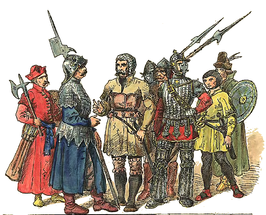Polish–Teutonic War (1519–1521)
This article needs additional citations for verification. (May 2012) |
| Polish–Teutonic War of 1519–1521 | |||||||||
|---|---|---|---|---|---|---|---|---|---|
| |||||||||
| Belligerents | |||||||||
|
Teutonic Knights |
Kingdom of Poland | ||||||||
| Commanders and leaders | |||||||||
|
| |||||||||
| Strength | |||||||||
| tens of thousands, but likely under 50,000 | tens of thousands, but likely under 50,000 | ||||||||
The Polish–Teutonic War of 1519–1521 (
Prelude

After the
Frederick died in December 1510, and Albert of Hohenzollern was chosen as his successor early in 1511 in the hope that his relationship to his maternal uncle,
In the meantime, however, the Order had been looking for other allies. In 1512,
The war

Polish forces under
The war grew, with Polish forces from the Duchy of Masovia and Gdańsk striking the nearby Teutonic fortifications. Teutonic forces were on defense, waiting for reinforcements from Germany, which arrived in the summer of 1520. In July, the Teutonic army started an offensive, attacking Masovia, Warmia, and Łomża territories, laying siege to Lidzbark Warmiński. In August, another group of German reinforcements attacked Greater Poland, taking Międzyrzecz. The Germans took Wałcz, Chojnice, Starogard Gdański, and Tczew and started a siege of Gdańsk, but they retreated when faced with Polish reinforcements and plagued by financial troubles (German reinforcements, mostly mercenaries, refused to fight until paid). Polish forces retook Tczew, Starogard, and Chojnice. The Teutonic Knights retreated towards Oliwa and Puck, pursued by Polish forces. The Polish side was then struck with financial troubles, and the "pospolite ruszenie" forces were also tired. The Teutonic Knights seized their chance and launched a counteroffensive, taking Nowe Miasto Lubawskie and approaching Płock and Olsztyn. Olsztyn was successfully defended by the Poles under the command of Nicolaus Copernicus.[1][2]
At that point, the Ottoman Empire invaded Hungary, and the new Holy Roman Emperor, Charles V, demanded that the Teutonic Knights and Poles stop their hostilities and aid the defense of Europe against the infidels. Both sides, tired with the war, agreed to an armistice on 5 April 1521 in the Compromise of Thorn.
Aftermath

During the four-year truce, the dispute was referred to Emperor Charles V and other princes, but no settlement was reached. Albert continued his efforts to obtain help in view of the inevitable end of the truce.
Eventually, in
See also
References
- Treaty of Kraków
- (in Polish) Wojny polsko-krzyżackie, WIEM Encyklopedia



